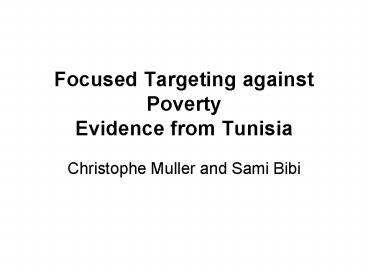Focused Targeting against Poverty Evidence from Tunisia
1 / 21
Title:
Focused Targeting against Poverty Evidence from Tunisia
Description:
Focused Targeting against Poverty. Evidence from Tunisia. Christophe Muller and Sami Bibi ... Large part of the fiscal deficit. APTS = alternative ... –
Number of Views:85
Avg rating:3.0/5.0
Title: Focused Targeting against Poverty Evidence from Tunisia
1
Focused Targeting against PovertyEvidence from
Tunisia
- Christophe Muller and Sami Bibi
2
- Anti-poverty transfer schemes (APTS)
- Major policy
- Building block
- Based on predictions of living standards
- Insufficient accuracy
- Poverty, Leakage, Undercoverage
- Riots
3
- Tunisian Food Subsidies Program
- Large part of the fiscal deficit
- APTS alternative
- Usually predictions based on OLS regression
estimates - We focus on the poor with
- Censoring the dependent variable
- Using quantile regressions
- Link with optimal transfer schemes (BF97)
4
Perfect Targeting
- Minti (1/N) ?i ((z-yi-ti)/z)a.1yitiltz
- ?i ti B
- ti 0, ?i
- ti Ta(yi, z, B), ?i
- Known solution and easy
5
Imperfect Targeting
- Mint(.) ??0z ((z-y-t)/z)a f(y x) dy
- ??0z t(y x) f(y x) dy B
- t(y x) 0
- Estimating f non-parametrically?
- Accuracy loss
- Estimating quantiles of f
- Quantile regressions, but there are many
- Eliminating many non-poor in regressions
- 1 estimation close to z may give good results
6
The chain of treatment
- 1 Estimation demand system
- 2 Calculus of equivalent-income and living
standard indicators yi - 3 Estimation of the predictions of living
standards p_yi - 4 Calculus of the optimal transfers ti(X)
- 5 Estimation of poverty and targeting efficiency
- 6 Tests of stochastic dominance
7
- Censored quantile regressions
- Minb (1/N) ?i ??(yi-Max(0,Xib))
- ??(u)?-1ult0u
- Algorithm and bootstrap
8
Estimation
- QAIDS for food
- Blundell-Robin estimator
- Equivalent-Income eliminating food subsidies and
spatial price differences EI - Poverty and efficiency based on EI
- Incorporation of Subsidies or Transfers
- OLS, Tobit, Quantile reg., Censored quantile reg.
- Various censorship and anchors
9
The Data
- 1990 Tunisian consumption survey
- 7734 households
- Budget of food subsidies allows
- Poverty line of 358 Tunisian Dinars (DT)
- Official poverty lines EI
- 4 sets of correlates of living standards
10
The Correlates
- Regions
- Demographic characteristics
- House characteristics
- Occupation
- Education
11
Regions
- Great Tunis
- Northeast
- Northwest
- Middle east
- Middle west
- Sfax
- Southeast
- Southwest
12
Demographic information
- Number of children in household old less than 2
years old. - Number of children aged between 3 and 6 years.
- Number of children aged between 7 and 11 years.
- Number of adults aged between 12 and 18 years.
- Number of adults old more than 19 years.
- Age of the household head (HH).
- Squared age of the HH.
13
House
- Number of rooms per capita
- 1 if household lives in a detached house, 0
otherwise. - 1 if household lives in a flat, 0 otherwise.
- 1 if household lives in an Arab house, 0
otherwise. - 1 if household lives in a hovel, 0 otherwise.
14
Occupation
- Dummy variable for HH living in Great Tunisia is
unemployed. - Dummy variable for HH living in the Northwest is
unemployed. - Dummy variable for HH living in the South (east
or west) is unemployed. - Dummy variable for HH living in another region is
unemployed. - Dummy variable for HH living in Southeast is
agricultural laborer. - Dummy variable for if HH living in Southwest is
agricultural laborer. - Dummy variable for if HH living in another region
is agricultural laborer. - Dummy variable for if HH is not agricultural
laborer. - Dummy variable for if HH is agricultural farmer.
- Dummy variable for if HH living in Northwest is
agricultural farmer. - Dummy variable for if HH is self-employed or
manager. - Dummy variable for if HH has another type of job.
15
Education
- Dummy variable for HH is illiterate.
- Dummy variable for HH has a primary schooling
level. - Dummy variable for HH has a junior secondary
schooling level. - Dummy variable for HH has a senior secondary
schooling level. - Dummy variable for HH has a higher educational
level.
16
Results
- Normality and Homoscedasticity of perturbations
are rejected - Log real consumption per capita
- Expected signs in living standard equations
- Most coefficients are significant
17
Goodness-of-fit
- OLS have highest pseudo-R2 (0.5)
- Tobit have lower pseudo-R2 (0.33)
- (Censored) Quantile regressions much less
efficient (0.12) - But when focusing on 1st and 2nd quantiles of
living standards - Quantile regressions yields the highest
prediction efficiency (for the poor)
18
Simulated Poverty Curves
19
Targeting Efficiency Statistics
20
Conclusion
- Using estimation methods focusing on the poor
and near-poor can dramatically improve the
performances of APT - The small level of undercoverage may remove
political obstacles to the implementation of APTS
21
Related projects
- QAIDS
- Price correction and anti-poverty targeting
- APTS and Calculus of variations
- Optimal estimator for APTS































